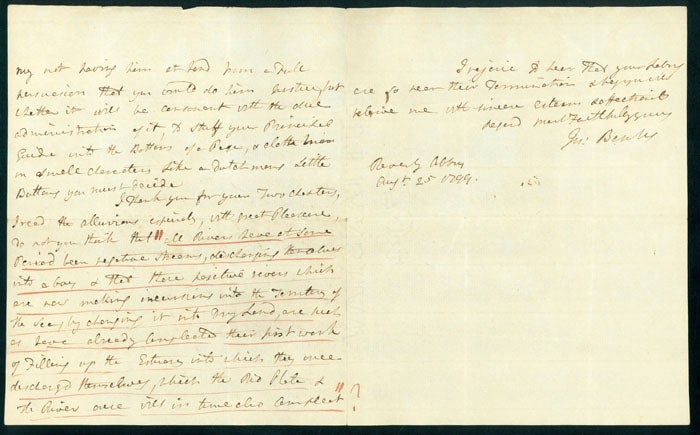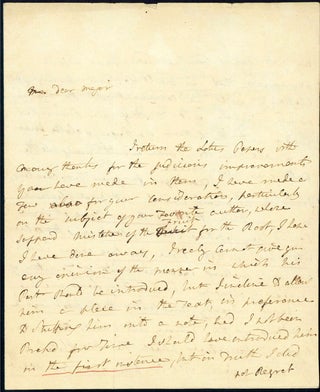Autograph letter signed to Maj. James Rennell
Publisher Information: Lincolnshire: 1799.
Banks, Joseph (1743-1820). Autograph letter signed to “My dear Major”; i.e. James Rennell (1742-1830). 2 – 1/2 pages. Revesby Abbey, Lincolnshire, August 25, 1799. 225 x 184 mm. Faint pencil sketch accompanied by a column of numbers on the blank verso of the second leaf; some words and phrases underlined neatly in red ink, possibly by the recipient. Fine.
From noted botanist and patron of science Joseph Banks, who accompanied Captain James Cook on the latter’s famous voyage of discovery to the South Pacific on H.M.S. Endeavour (1768-71). During that voyage Banks described and collected hundreds of species of exotic flora, many of which were then new to science; the genus Banksia, comprising about 170 species native to Australia, is named for him. Banks served as president of the Royal Society from 1778 until his death, and also headed the Royal Botanic Gardens at Kew, which under his leadership became one of the pre-eminent botanical gardens in the world. Banks’ correspondent was geographer and historian James Rennell, who as an officer in the British East India Company was appointed to conduct the first survey of the territory of Bengal; his results were published in A Bengal Atlas (1779). Rennell returned to London in the late 1770s where he devoted himself to geographical research, particularly as pertaining to classical and biblical times. He was elected a member of the Royal Society in 1781 and became close friends with Banks.
Banks’ letter to Rennell discusses Rennell’s The Geographical System of Herodotus (1800), which was then nearing completion. The letter indicates that Rennell was in the habit of submitting work to Banks for his comments and criticism:
"I return the Lotus Papers with many thanks for the judicious improvements you have made in them. I have made a few also for your consideration, particularly on the subject of your favourite author [Herodotus], whose supposed mistake of the fruit for the root, I hope I have done away. I realy [sic] cannot give you any opinion of the manner in which his part should be introduced, but I incline to allow him a place in the text, in preference to stuffing him into a note. Had I not been pressed for time I should have introduced him in the first instance, but in truth I did not regret my not having him at hand from a full persuasion that you could do him justice, but whether it will be consonant with the due administration of it, to stuff your principal guide into the bottom of a page, & clothe him in small characters like a Dutchman’s little buttons you must decide."
Herodotus described the white lotus (Nymphaea Lotus) in his account of the Lotus-eaters portrayed in Homer’s Odyssey. The plant is a flowering shrub native to Egypt with edible seeds, fruits and roots. Rennell included in his treatise a historical and botanical dissertation on both the white lotus and the water lotus (Nelumbo); he paid tribute to Banks for his contribution in a footnote on p. 630 in which he stated that “for the following observations on the aquatic lotus, as well as some remarks on the subject of the lotus at large, the Author is indebted to a highly distinguished friend.”
In the remainder of the letter Banks discussed two chapters on rivers included in Rennell’s Geographical System:
"I thank you for your two chapters. I read the alluvions especially, with great pleasure. Do you not think that all rivers have at some period been negative streams, discharging themselves into a bay & that these positive rivers which are now making incursions into the territory of the sea, by changing it into dry land, are such as have already completed their first work of filling up the estuary into which they once discharged themselves, which the Rio Plate & the River Ouse will in time also compleat."
On page 483 of his Geographical System Rennell distinguished between rivers that terminate negatively by emptying into a deep estuary, or positively by forming a projecting delta. Banks in his letter suggests that the first type evolves over time into the second.
Neil Chambers, editor of The Scientific Correspondence of Sir Joseph Banks 1765-1820 (2006), includes other letters concerning this particular exchange from Rennell to Banks in volume 5 of The Indian and Pacific Correspondence of Sir Joseph Banks, 1768-1820 (2012). Letters both before and after it are also featured in this volume.
Book Id: 42813Price: $6,500.00


